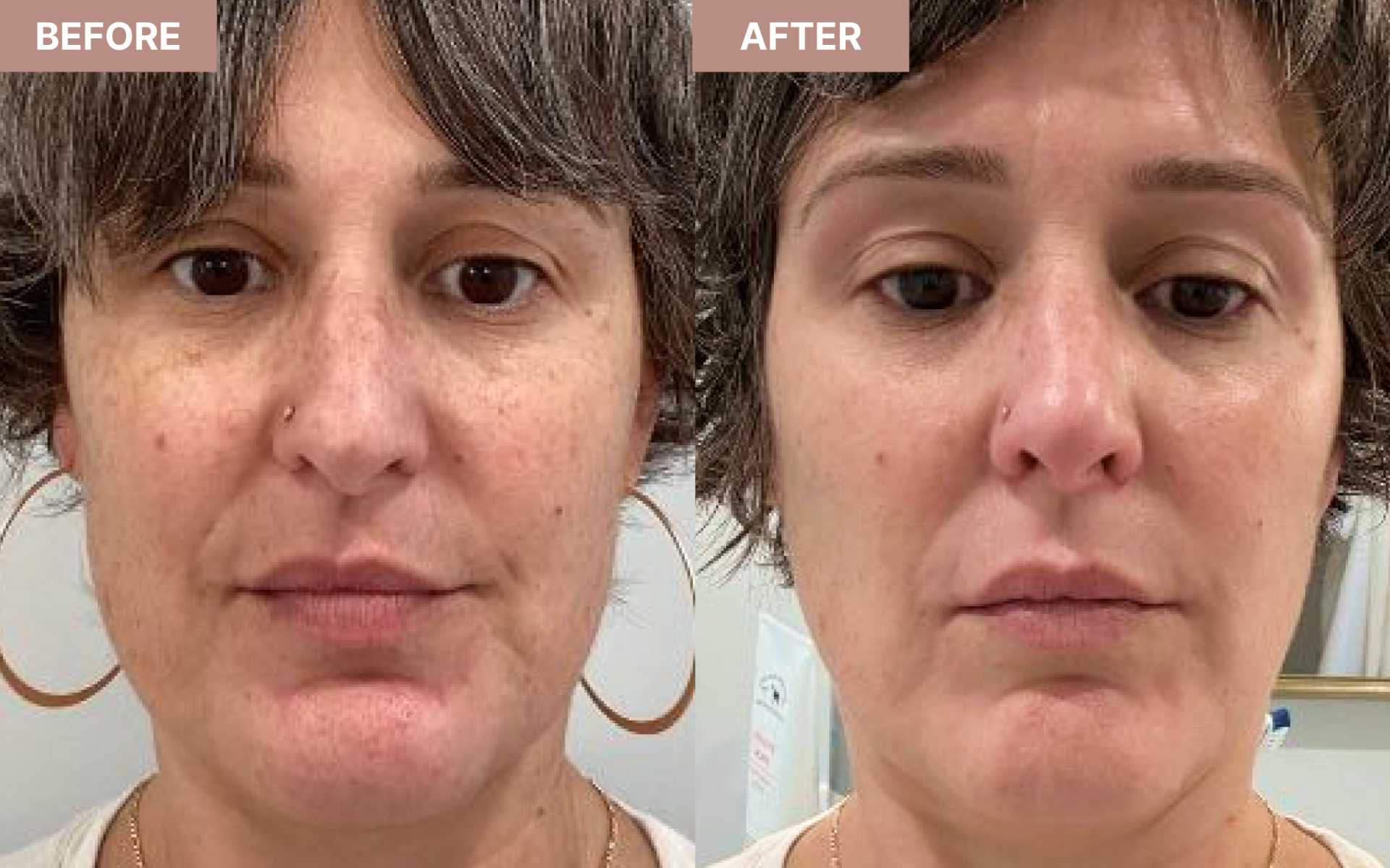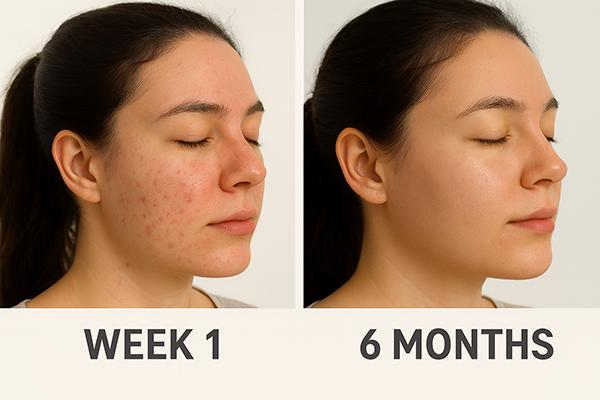Tretinoin, a derivative of vitamin A, is recognized globally for transforming skin texture, tone, and cellular health. Dermatologists prescribe it for acne, photoaging, hyperpigmentation, and uneven texture.
Understanding tretinoin before and after effects helps you track changes accurately and manage expectations throughout the treatment timeline. This guide explains every stage from the first application to long-term results using dermatological evidence, real experiences, and professional usage strategies.

What Is Tretinoin and How Does It Work?
Tretinoin (all-trans retinoic acid) is a topical retinoid that accelerates cell turnover, stimulates collagen, and reduces keratin plug formation in pores.
When applied, it binds to retinoic acid receptors (RARs) in skin cells. This action regulates gene expression that affects pigmentation, elasticity, and inflammation.
Core Benefits
-
Reduces comedonal and inflammatory acne
-
Fades sun-induced dark spots and uneven tone
-
Increases dermal collagen and skin elasticity
-
Minimizes fine lines and roughness
-
Smooths surface texture over time
Tretinoin remains one of the few ingredients clinically proven to modify skin structure, not just its surface appearance.
Tretinoin Before and After: What to Expect at Each Stage
Week 1–4: The Adjustment Period
The first month is the skin adaptation phase.
-
Mild irritation, redness, and dryness often appear as the skin adjusts.
-
Dead cells begin to shed, exposing new epidermal layers.
-
Acne-prone users may experience a “purge”, where hidden comedones surface before clearing.
Professional Tip: Apply a pea-sized amount to completely dry skin and follow with moisturizer to buffer irritation.
Week 5–8: Visible Surface Renewal
As tolerance develops, inflammation decreases.
-
Pores start appearing smaller due to reduced blockages.
-
Active acne lessens, and post-inflammatory pigmentation begins to fade.
-
Texture becomes slightly smoother, though dryness can persist.
During this phase, consistent sunscreen use becomes vital — tretinoin increases UV sensitivity.
Month 3–6: Structural Improvement
By the third month, tretinoin begins influencing the dermal matrix.
-
Collagen synthesis increases; early fine lines soften.
-
Skin tone appears brighter and more uniform.
-
Breakouts become less frequent and heal faster.
Clinical studies show that after 12 weeks of use, tretinoin improves skin firmness and reduces mottled pigmentation by up to 30 percent.
Month 6–12: Deep Collagen Remodeling
Long-term users often see the most dramatic “after” changes here.
-
Wrinkle depth diminishes as new collagen fibers organize.
-
Roughness and scarring fade gradually.
-
Overall clarity and radiance increase.
At this point, most users report stable tolerance with minimal peeling. Many dermatologists consider 6–12 months the optimal evaluation window for complete transformation.
Tretinoin Progress Timeline
| Time Frame | Skin Response | Visible Results | Suggested Routine |
|---|---|---|---|
| Week 1–2 | Redness, dryness, purge | Minimal change | 2–3× per week, buffer with moisturizer |
| Week 3–6 | Smoother texture | Early clarity | Alternate nights, daily SPF |
| Month 3–6 | Collagen stimulation | Fewer breakouts, brighter tone | Nightly use, increase strength if tolerated |
| Month 6–12 | Full remodeling | Firmer, more even skin | Maintain nightly, hydrate AM/PM |
Before and After Effects on Different Skin Concerns
1. Acne and Breakouts
Tretinoin reduces microcomedones, unclogs pores, and prevents new lesions.
After 3 months, active acne typically declines by 60 percent or more. The “after” phase shows clearer skin, fewer blackheads, and reduced oiliness.
2. Post Inflammatory Hyperpigmentation (PIH)
By promoting uniform cell turnover, tretinoin fades dark marks faster than natural exfoliation alone.
Visible fading begins near 8–12 weeks, with continued improvement for 6–9 months.
3. Fine Lines and Wrinkles
Collagen stimulation increases dermal thickness.
Clinical imaging shows measurable wrinkle depth reduction within 24 weeks of consistent 0.05% use.
4. Uneven Skin Texture
Smoother surface texture is one of the earliest benefits.
Users frequently report improved makeup adherence and overall luminosity by the third month.
5. Photoaging and Sun Damage
Tretinoin reverses early photodamage by repairing elastin and stimulating new collagen.
Pigmented spots and roughness visibly decline over 6–12 months.
How to Apply Tretinoin Correctly
-
Cleanse Gently – Use a mild, non-foaming cleanser; pat skin dry.
-
Wait 20 Minutes – Apply tretinoin only on fully dry skin to reduce stinging.
-
Use a Pea-Sized Amount – Spread evenly over the face (avoid eyelids, corners of nose, lips).
-
Follow With Moisturizer – Lock in hydration to counteract dryness.
-
Apply at Night Only – Retinoic acid degrades in sunlight.
-
Always Use SPF 30+ in the Morning – Prevent photosensitivity and pigment relapse.
Barrier Safe Routine Example
Night Routine
-
Cleanser
-
Wait 20 minutes
-
Tretinoin (0.025%–0.05%)
-
Moisturizer (ceramide or glycerin-based)
Morning Routine
-
Hydrating cleanser
-
Antioxidant serum (optional Vitamin C)
-
Lightweight moisturizer
-
Broad-spectrum sunscreen SPF 50
Common Mistakes New Users Make
-
Applying too much product — causes irritation without added benefit.
-
Using it on wet skin — increases absorption and burning.
-
Combining multiple actives (AHA, BHA, benzoyl peroxide) simultaneously.
-
Skipping sunscreen — negates progress and induces redness.
-
Inconsistent application — delays visible improvement.
-
Abandoning treatment during purging — interrupts skin renewal cycle.
Understanding the Tretinoin Purge
The purge is a temporary flare-up of acne-like lesions when dormant clogs surface rapidly.
It typically lasts 2–6 weeks and occurs in areas where you usually break out.
Unlike allergic reactions, purging follows predictable healing patterns — pimples form, dry, and clear within days.
Keeping a log of onset and recovery helps distinguish purge from irritation.
Key Signs of Purge vs. Reaction
| Feature | Purge | Allergic Reaction |
|---|---|---|
| Location | Normal breakout zones | Unusual areas (e.g., neck, eyelids) |
| Duration | 2–6 weeks | Persistent or worsening |
| Appearance | Small whiteheads/comedones | Burning, itching, swelling |
| Management | Continue cautiously | Discontinue and consult dermatologist |
Realistic “After” Transformations
After 1 Month
-
Mild smoothness and reduced oil
-
Possible dryness and flakes
-
Acne stabilization begins
After 3 Months
-
Clearer skin, lighter spots, refined pores
-
Noticeable glow under natural light
After 6 Months
-
Collagen density increases
-
Fewer wrinkles, balanced tone
-
Texture even and luminous
After 12 Months
-
Sustained clarity, stronger barrier
-
Elasticity restored
-
Consistent youthful appearance
Top Complementary Ingredients
| Ingredient | Function | Best Use Time |
|---|---|---|
| Niacinamide (2–5%) | Strengthens barrier, reduces redness | Morning & night |
| Hyaluronic Acid | Retains moisture | After tretinoin |
| Vitamin C (L-Ascorbic Acid) | Brightens, protects from oxidation | Morning |
| Peptides | Support collagen | Morning or evening |
| Panthenol & Ceramides | Restore hydration | Post-tretinoin |
When combined correctly, these ingredients accelerate the “after” phase without aggravating sensitivity.
Who Should and Should Not Use Tretinoin
Ideal Candidates
-
Adults with mild-to-severe acne
-
Individuals with sun damage or early aging signs
-
Those with persistent hyperpigmentation
-
People seeking preventive anti-aging regimens
Avoid or Delay Use If
-
Pregnant or breastfeeding
-
Having eczema, rosacea, or open wounds
-
Using strong exfoliants or isotretinoin simultaneously
-
Experiencing uncontrolled sensitivity
Safety and Maintenance Practices
-
Use only dermatologist-prescribed formulations.
-
Do not combine tretinoin with laser treatments or chemical peels in early months.
-
Avoid waxing treated areas; skin becomes thinner and delicate.
-
Hydrate adequately — internal water intake supports epidermal function.
-
Continue sunscreen even on cloudy days or indoors (UV passes through glass).
Long-term maintenance: once optimal results appear, many dermatologists recommend reducing frequency to 3–4 nights per week for preservation.
Scientific Evidence Supporting Tretinoin
-
A 48-week study published in Journal of the American Academy of Dermatology found that 0.05% tretinoin improved fine wrinkles and mottled hyperpigmentation significantly versus placebo.
-
Controlled trials confirmed that collagen I content in dermis increased by up to 80 percent after six months.
-
Longitudinal studies proved continued use sustains results without tachyphylaxis (reduced efficacy).
These findings reinforce tretinoin’s unique role as a molecularly active compound capable of reversing structural aging, not just masking it.
Lifestyle Support for Better Results
-
Nutrition – Adequate protein and antioxidant intake (vitamin E, selenium) promote collagen synthesis.
-
Hydration – 2–3 liters of water daily supports dermal recovery.
-
Sleep Hygiene – Collagen production peaks during sleep; 7–8 hours essential.
-
Stress Management – High cortisol aggravates inflammation and acne recurrence.
-
Consistent Routine – Skin adaptation depends on daily, steady application rather than intensity.
Common Myths Debunked
| Myth | Fact |
|---|---|
| Tretinoin thins skin | It thickens the dermis while exfoliating the stratum corneum |
| Peeling equals effectiveness | Over-peeling indicates irritation, not progress |
| It works only for acne | Proven benefits for aging, pigment, and texture |
| Stronger formulas work faster | Concentration must match tolerance |
| Moisturizers block tretinoin | They improve absorption and tolerance |
Advanced Users: Microdosing and Sandwich Techniques
Microdosing uses a smaller-than-pea quantity spread evenly to maintain results with less irritation.
Sandwich Method involves applying moisturizer before and after tretinoin — ideal for sensitive users.
Both methods preserve efficacy while supporting barrier resilience.
Expected Long Term “Before and After” Transformation Summary
| Parameter | Before | After 12 Months of Consistent Use |
|---|---|---|
| Texture | Rough, uneven | Smooth, refined |
| Tone | Dull, pigmented | Bright, uniform |
| Pores | Clogged, enlarged | Clean, minimized |
| Acne | Frequent | Rare, mild |
| Lines/Wrinkles | Visible | Softened or minimal |
| Elasticity | Mild sag | Firm, resilient |
Best Practices to Capture Before and After Photos
-
Use identical lighting and background.
-
Keep camera at the same distance and angle.
-
Avoid filters or retouching.
-
Record date, tretinoin strength, and frequency under each image.
-
Take photos every 30 days for consistent tracking.
Documenting progress accurately enhances credibility and motivation during long treatments.
Frequently Asked Questions
1. How long does it take to see tretinoin results?
Most users notice texture changes in 4–8 weeks and major improvements between 3–6 months. Full structural remodeling occurs within 12 months.
2. Can tretinoin permanently clear acne?
It controls acne long-term by preventing comedone formation, but maintenance use is required to sustain remission.
3. Does tretinoin lighten skin tone permanently?
No, it restores natural tone by dispersing excess melanin; results depend on sun protection and ongoing use.
4. Can I use tretinoin under the eyes?
Only if prescribed; under-eye skin is delicate and needs lower concentration or alternate retinoid.
5. Is tretinoin safe to combine with vitamin C?
Yes — use vitamin C in the morning and tretinoin at night to reduce potential irritation.
6. Why does my skin look worse before it improves?
Accelerated turnover reveals underlying imperfections temporarily (purge phase) before renewal balances out.
7. What strength should beginners start with?
Dermatologists often recommend 0.01%–0.025% creams, increasing gradually as tolerance builds.
8. Does tretinoin stop working over time?
No. Continuous use maintains collagen stimulation; the skin simply becomes more tolerant, reducing side effects.
9. Can I wear makeup after applying tretinoin?
Yes, after full absorption (20–30 minutes). Choose non-comedogenic formulas.
10. Should I exfoliate while using tretinoin?
Avoid physical scrubs; if needed, use mild lactic acid once weekly after the adaptation period.
Learn More: What to Wear to a Funeral: The Ultimate Guide
Date Ideas Near Me: The Ultimate Guide to Creative, Fun, and Romantic Experiences
Conclusion
The “tretinoin before and after” journey is one of science-backed renewal. From cellular regeneration to collagen reinforcement, every stage contributes to a healthier, more radiant complexion. Patience, consistency, and protection are the pillars of success. With the correct application routine and dermatologist guidance, tretinoin remains the most potent topical agent for lasting skin transformation.

